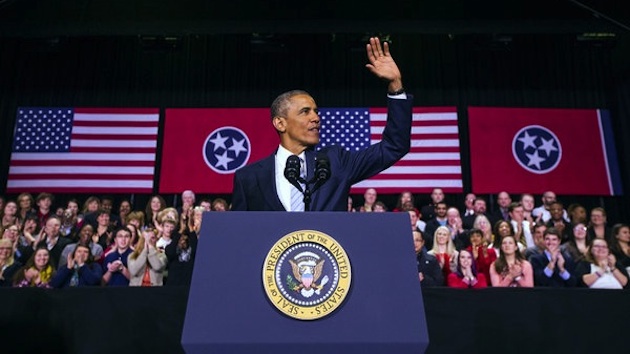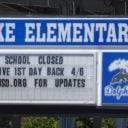

President Obama spoke Friday in Tennessee, which is starting its own tuition program for community college students. His proposal, modeled after Tennessee’s, is to make the schooling free. (Photo: Jabin Botsford/The New York Times)
Last Friday, President Obama unveiled his proposal to spend $60 billion over the next 10 years to provide free community college tuition to roughly 9 million students each year.
“Two years of college will become as free and universal as high school is today,” the president claimed.
However, many critics are quick to point out several serious flaws with Mr. Obama’s plan, which on the merits, appears more a political strategy than an economic strategy. Free and universal public education is in desperate need of reform, chronically suffering from problems that a continued increase of funding has not been capable of rectifying.
“Maybe we should take another look at ‘free education’ because it’s worked out so well in regards to high school and grammar school, both of which turn out miserable excuses for uneducated kids on a regular basis,” said Thomas Purcell, host of Liberty Never Sleeps and youngest graduate of Mesa. Purcell recently argued Obama’s plan focuses on quantity of education, not quality of education.
It is a concern that many on the president’s own end of the political spectrum say they share with Purcell and others on the right. “We should be much more concerned about quality and about completion,” said Sandy Baum, a senior fellow at the Urban Institute. Baum, a research professor at the George Washington University’s Graduate School of Education and Human Development, could only tell the New York Times that there might be a “potential financial benefit” to expanded access.
But others, even those on the left, aren’t that tactful.
“He shouldn’t be holding Tennessee Promise out as a model because it’s not a model; it’s a facade to cover up what is a dying system,” said Representative Steve Cohen, s Democrat from Tennessee and the architect of Tennessee’s HOPE college program.
Rep. Cohen said both the state program and Obama’s proposal help affluent and lower-achieving students, not those with financial hardship or have the best chance of academic success. While the president claims it will help the economically challenged, it would also pay for the tuition of middle- and upper-income students who do not qualify for it currently, nor do they need it.
He now believes education benefits to help pay for college tuition should be a system that rewards students for achievement.
Aside from concerns the president’s plan emphasizes quantity over quality, there is also the very serious two-point argument that holds 1) it is a wholly unneeded government intervention to a manufactured problem and, 2) more government intervention will only create a dire crisis.
First, community college is already tuition-free for most of the targeted students around the country. The federal Pell grant program covers low- and middle-income students up to $5,730 a year, and most states have their own grant programs that can be compounded with federal financial aide. With the national average for full-time community college tuition and fees at only $3,427, students are left with a considerable amount to put toward living expenses.
Undoubtedly, the president’s proponents would take issue with that assertion, but the data just don’t support their position.
A recent report from the Consumer Financial Protection Bureau (CFPB) found students aren’t having a difficult time obtaining financial assistance to pay for tuition. The Dodd-Frank Wall Street Reform and Consumer Protection Act required the CFPB to submit an annual report that analyzes complaints submitted by consumers, most recently from October 1, 2013, through September 30, 2014.
The report concluded that those who are in need of more financial assistance have little trouble taking out student loans with fair interest rates. However, what they found was that they couldn’t pay them back, because they couldn’t find a job.
The CFPB found 57 percent cited “repaying my loan/dealing with my lender” and 41 percent cited “problems when you are unable to pay/can’t repay my loan” as their number one problem. That’s a frightening finding, considering the class of 2014 graduated with an average student loan debt of $33,000. Even if we adjusted for inflation using the government’s bogus numbers and methods, that’s still nearly double the amount borrowers had to pay back 20 years ago.
The findings suggest the real problem is cost and post-college opportunity, not expanded access. Yet, the president’s plan does nothing to address cost, nor does it deal with the danger of current student debt defaulting en masse, which would dwarf the subprime mortgage crisis.
According to the CFPB, student loan debt ballooned to approximately $1.5 trillion in 2014. With the U.S. national debt surpassing $18 trillion, student loan debt now represents 6 percent of the total debt-blanket hanging over the economy. The amount of consumer debt from student loans is second only to mortgages, and the vast majority of student loans are already backed by the U.S. government through banks like Sallie Mae, or since 2010, by the Department of Education.
Unfortunately, they are also representative of the majority of loans that debts holders say they cannot pay back, by far. Obama’s plan would only shift more of the burden to the taxpayers, who are already in danger of being on the hook for another bailout.
Mr. Obama said the federal government will pay three-quarters of tuition costs, while the states pay one-quarter. Of course, as with public school education, federal monies will come with strings attached. Those strings have done nothing to improve America’s failing public schools, and will do nothing for community colleges.
It has long been a cultural belief that higher education leads to more opportunity. But, in today’s economy, it isn’t holding up to scrutiny, and that’s true even of advanced degrees. A recent paper published in the Journal of EconomicPerspectives found PhD research conducted by some of those with the most expensive degrees is grossly lagging in productivity.
“If the objective of graduate training in top-ranked departments is to produce successful research economists, then these graduate programmes are largely failing,” says John P. Conley and Ali Sina Önder, the authors of the new report. “Our evidence shows that only the top 10–20 percent of a typical graduating class of economics PhD students are likely to accumulate a research record that might lead to tenure at a medium-level research university. Perhaps the most striking finding from our data is that graduating from a top department is neither necessary nor sufficient for becoming a successful research economist.”
To make a long report short, government programs saturated the market for advanced degrees and reduced their value, thus reducing productivity. As a result of the private-public partnership between universities and the government, there are way too many PhDs produced each year juxtaposed to the number of job openings. More than 100,000 doctoral degrees were shelled out in the United States between 2005 and 2009, but in the same period there were just 16,000 new professorships.
Rather than increasing access to and the quantity of college degrees, while inevitably decreasing productivity, Purcell suggests we do just the reverse.
“Why don’t we consolidate all the community colleges into high schools and, that way, maybe a high school diploma will actually be worth something?” he proposed in a question. “It will save states a boat-load of money and make both high school and the community colleges viable again as institutions of learning, rather than places to fritter away an afternoon learning how to weave a basket.”





Eric Shoup / January 13, 2015
Why does this article make the jump from obtaining scholarships to paying back student loans? A little bit of a jump there. If the college is provided (free-of-charge) the student would have no debt for student loans, correct? Also, if free community college is provided, logically enrollment would increase. Wouldn’t that create a benefit for the community colleges via increased income from a new wave of students?
/
Alaska Young / May 19, 2015
Great news!
/
Jennifer Underwood / May 19, 2015
In my opinion, it’s great that students will have an access to free college tuition. It’s hard to say how many US students are struggling because of high tuition costs. Many American families are deeply in debt because they have sent their kids to college. But on the other hand, such a decision will impact the economy and indeed everything is not as sweet as it sounds. Student loan debt is a huge issue and its figure is still rising so there should be something to stop it. Jennifer from Personal Money Service company.
/